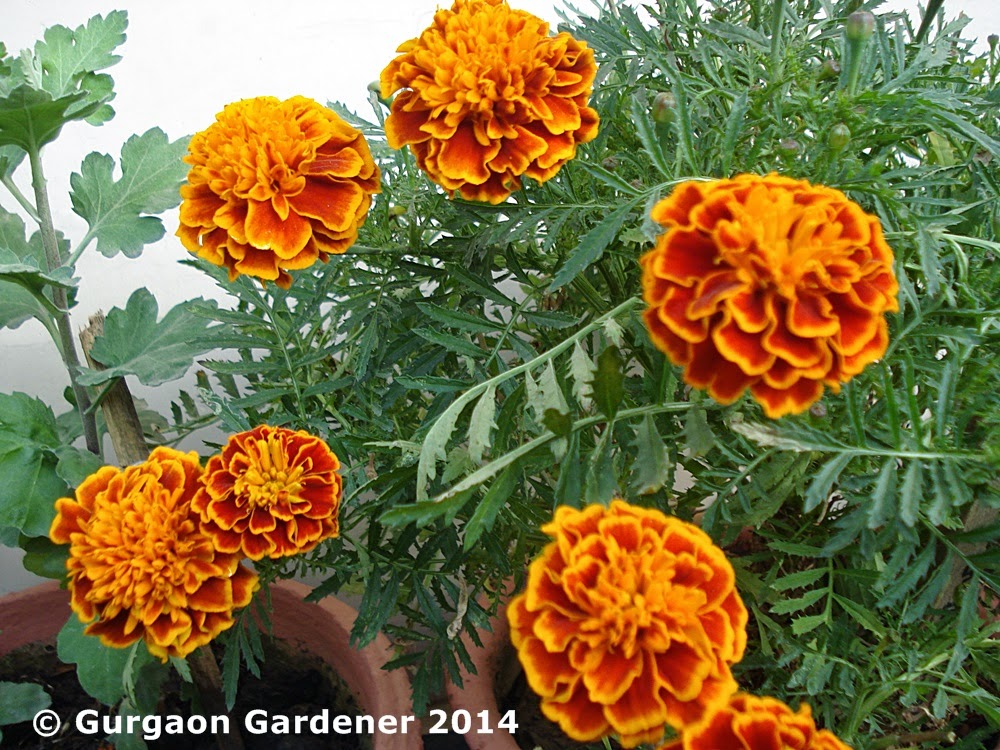Marigold (Hindi Name - Genda गेंदा)
Species: Tagetes erecta, Tagetes patula
Marigold
are among the very popular flowers commonly found in India and other countries.
They can be easily cultivated, are widely adaptable to varying soils and
climatic conditions and have a good flowering duration. This bushy plant with
around 20 to 30 species, have a long flowering period and the colours range
from orange, yellow, gold, cream to apricot. They are very much used in making
garlands. Make excellent beds and pot decorations.
African Marigold
There's
nothing subtle about an African marigold, and thank goodness for that! It's a
big, flamboyant, colorful punch of color for the sunny bed, border, or large
container. Most are yellow, orange, or cream. Plants get up to 3 feet tall and
produce huge 3-inch puffball blooms while dwarf varieties get just 1 foot tall.
The mounded dark green foliage is always clean, fresh, and tidy. Grow them in a
warm, sunny spot with moist, well-drained soil all summer long.
Growing
Marigold
Light: Sun
Type: Annual
Height: 1 to 3 feet
Width: 1 - 2 feet wide
Flower Color: Orange, Yellow, Cream
Seasonal Features: Fall Bloom, Summer Bloom
Problem Solvers: Drought Tolerant, Groundcover
Propagation: Seed
Special Features: Fragrance, Good for Containers, Low
Maintenance
 French
Marigold
French
Marigold
Just as you'd expect from something called French, these marigolds are
the fancy ones. French marigolds tend to be frilly and some boast a distinctive
"crested eye." They grow roughly 8-12 inches high with a chic, neat,
little growth habit and elegant dark green foliage.
They do best in full sun with moist, well-drained soil and will flower all summer long. They may reseed, coming back year after year, in spots where they're happy.
Marigolds Care
Planting
Sow them directly into the garden once the soil is warm, or start seeds indoors about a month to 6 weeks before the last spring-frost date.
Sow them directly into the garden once the soil is warm, or start seeds indoors about a month to 6 weeks before the last spring-frost date.
The
seeds germinate easily, but watch out for damping off if you start them inside.
Separate seedlings when they are about 2 inches tall. Plant them in flats of loose soil, or transplant them into the garden.
Separate seedlings when they are about 2 inches tall. Plant them in flats of loose soil, or transplant them into the garden.
Space tall marigolds
2 to 3 feet apart; lower-growing ones about a foot apart.
If planting in containers, use a soil-based potting mix; during growing season, water freely and apply a balanced liquid fertilizer weekly.
If planting in containers, use a soil-based potting mix; during growing season, water freely and apply a balanced liquid fertilizer weekly.
Light & Soil
Marigolds need lots of sunshine (at least six hours of direct sunlight) and do well with year round warm to hot weather.
Though they grow in almost any soil, marigolds thrive in moderately fertile, well-drained soil.
Marigolds need lots of sunshine (at least six hours of direct sunlight) and do well with year round warm to hot weather.
Though they grow in almost any soil, marigolds thrive in moderately fertile, well-drained soil.
Watering
Water marigolds the first 10 to 12 days after transplanting bedding plants into the garden. Thereafter, water the plants once every week without rainfall. Water deeply to saturate the roots and then allow the soil to dry before watering again. Marigolds are drought-tolerant plants that may develop rot, mildew or other diseases in soggy soil.
Water marigolds the first 10 to 12 days after transplanting bedding plants into the garden. Thereafter, water the plants once every week without rainfall. Water deeply to saturate the roots and then allow the soil to dry before watering again. Marigolds are drought-tolerant plants that may develop rot, mildew or other diseases in soggy soil.
Fertilizing
Avoid fertilizing the plants. Marigolds thrive in poor soil and fertilizer often creates lush, rich foliage with few blooms.
Avoid fertilizing the plants. Marigolds thrive in poor soil and fertilizer often creates lush, rich foliage with few blooms.
Deadheading
Pinch off, or deadhead marigold blooms as soon as they fade to encourage continued blooming. Otherwise, the plants go to seed early and blooming rapidly decreases. To deadhead marigolds, remove the bloom, along with the stem down to the next branching stem, bud or leaf.
Pinch off, or deadhead marigold blooms as soon as they fade to encourage continued blooming. Otherwise, the plants go to seed early and blooming rapidly decreases. To deadhead marigolds, remove the bloom, along with the stem down to the next branching stem, bud or leaf.
Hope you enjoy the beauty!!
Happy Gardening and Always Live your Passion!!
Shared with ABC Wednesday, Wordless Wednesday, Today's flower, Floral Flower Fotos, Ruby Tuesday Too and Outdoor Wednesday.